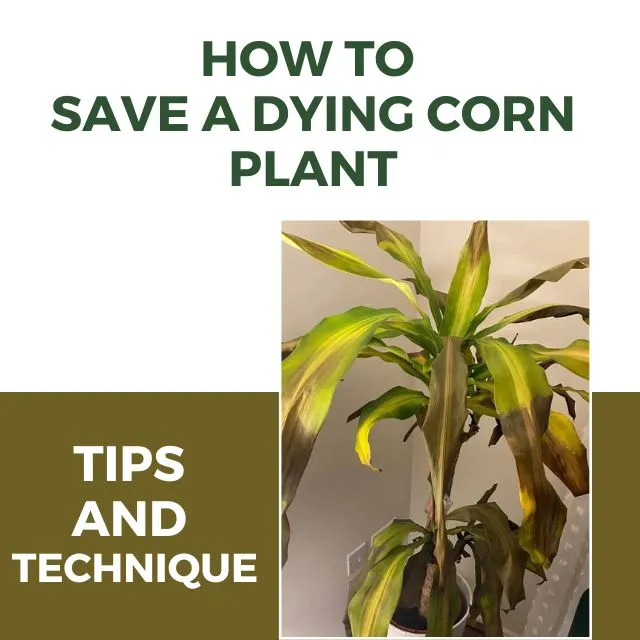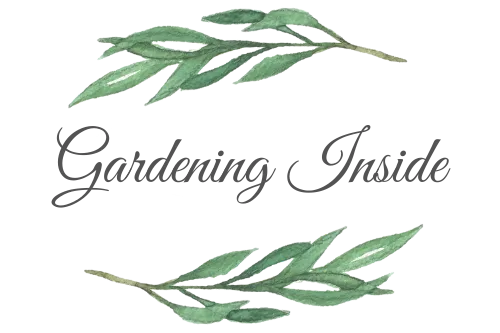Corn plants are a popular indoor plant that can add a touch of greenery and vibrancy to your home. These plants are relatively easy to grow, but they can suffer from various problems that can cause them to die.
However, with the proper care and attention, you can save a dying corn plant and help it recover. In this article, we will discuss in detail the reasons and how to save a dying corn plant and the steps you can take to restore its health.

Characteristics of the Corn Plant
The corn plant, also known as Dracaena fragrans, is a popular indoor plant that is known for its attractive foliage and easy care requirements.
Here are some of the key characteristics of the corn plant:
- Foliage: The corn plant has long, narrow leaves that can reach up to 2 feet in length. The leaves are dark green and have a glossy, waxy texture.
- Size: Corn plants can grow up to 6 feet tall, making them a great choice for filling large spaces in the home or office.
- Growth rate: Corn plants are slow-growing and can take several years to reach their full height.
- Light requirements: Corn plants prefer bright, indirect sunlight but can tolerate low light conditions. Direct sunlight can scorch the leaves and cause them to turn brown.
- Water requirements: Corn plants need consistent moisture but can become stressed if they are over or under watered. Water the plant deeply once a week, allowing the soil to dry out slightly between waterings.
- Soil requirements: Corn plants prefer well-draining soil that is rich in organic matter. Use a potting mix that contains perlite, vermiculite, or sand to improve drainage.
- Temperature requirements: Corn plants prefer temperatures between 60 and 75 degrees Fahrenheit. They can tolerate cooler temperatures, but should not be exposed to temperatures below 55 degrees Fahrenheit.
- Air quality: Corn plants can help improve air quality by removing toxins such as formaldehyde and benzene from the air.
Overall, corn plants are a great choice for anyone looking for an attractive, low-maintenance indoor plant that can help improve air quality and add a touch of greenery to their home or office.
Why are my Corn Plants dying?
There can be several reasons why your corn plants may be dying. Here are some common causes:
1. Over or Under-Watering:
Corn plants need consistent moisture but can become stressed if they are over or under-watered. Overwatering can lead to root rot, while under watering can cause the plant to wilt and dry out.
2. Poor soil quality:
Corn plants prefer well-draining soil rich in organic matter. If the soil is poor quality, the plant may not be getting the nutrients it needs to grow properly.
3. Nutrient deficiencies:
Corn plants require nitrogen, phosphorus, and potassium, as well as trace amounts of other nutrients. If the plant is not getting enough nutrients, it may show signs of stunted growth, yellowing leaves, or other nutrient deficiency symptoms.
4. Pests and diseases:
Corn plants can be susceptible to pests such as spider mites, mealybugs, and aphids, as well as diseases such as fungal infections. Pests and diseases can weaken the plant and cause it to die.
5. Lack of light:
Corn plants require bright, indirect sunlight to grow properly. If the plant is not getting enough light, it may become weak and spindly, or it may not grow at all.
6. Environmental factors:
Corn plants can be sensitive to temperature, humidity, and air flow changes. If the plant is exposed to extreme temperatures or drafts, it may become stressed and die.
Also, Check: Hawaiian Spider Plants: Care, Propagation & Problems
How to save Dying Corn Plants?
Identifying the specific problem affecting your corn plants can help you take appropriate measures to address the issue and save your plant.
Identify the Problem:
The first step in saving a dying corn plant is to identify the problem. There are several reasons why a corn plant may be dying, including pests, disease, over or under watering, poor soil quality, and nutrient deficiencies.
Look for signs of pests or disease, such as yellowing or wilting leaves, discolored spots, or webbing.
Check the soil for moisture levels and signs of over or under watering, such as mold or fungus. If you suspect a nutrient deficiency, look for symptoms such as yellowing leaves or stunted growth.
Adjust Watering:
Once you have identified the problem, you can begin to take steps to save your corn plant. If the plant is over or under watered, adjust your watering schedule accordingly.
Corn plants need consistent moisture but can become stressed if they are over or under watered.
Water the plant deeply once a week, allowing the soil to dry out slightly between waterings. Make sure that the pot has proper drainage to prevent standing water.
Improve Soil Quality:
If the soil is poor quality, consider repotting the plant in fresh soil. Corn plants prefer well-draining soil that is rich in organic matter.
Use a potting mix that contains perlite, vermiculite, or sand to improve drainage. You can also add compost or other organic matter to the soil to improve its nutrient content.
Check Nutrient Levels:
If the plant is showing signs of nutrient deficiency, you may need to fertilize it. Corn plants require nitrogen, phosphorus, and potassium, as well as trace amounts of other nutrients.
You can purchase a balanced fertilizer designed for corn plants and apply it according to the package instructions. Be careful not to over-fertilize, as this can burn the roots and cause further damage.
Address Pests and Disease:
If the plant is suffering from pests or disease, you will need to take action to address the problem. Identify the specific pest or disease and choose an appropriate treatment.
For example, you can use insecticidal soap to treat aphids or a fungicide to treat fungal infections.
Be sure to follow the instructions carefully and monitor the plant for further signs of stress.
Provide Adequate Light:
Finally, make sure that the plant is getting adequate light. Corn plants require bright, indirect sunlight to grow properly.
If the plant is not getting enough light, move it to a brighter location or provide supplemental light using a grow light.
Conclusion:
Saving a dying corn plant requires careful attention to the plant’s needs. Identify the problem, adjust watering and soil quality, address nutrient deficiencies, pests and diseases, and provide adequate light.
With proper care and attention, your corn plant can recover and thrive. Remember to be patient and consistent in your efforts, and your plant will reward you with its beauty and vibrancy.
